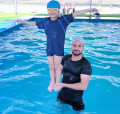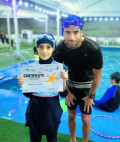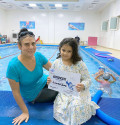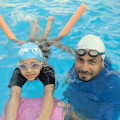
Kickboxing for Kids An Exciting Journey Filled with Valuable Life Lessons
2024-01-29 - kick-boxingI. Introduction
Definition of Kickboxing for Kids
Kickboxing for kids involves a modified form of the sport
tailored to suit the developmental needs of children. It combines elements of
traditional kickboxing with age-appropriate techniques and safety measures.
Growing Popularity
In recent years, kickboxing for kids has witnessed a surge
in popularity. Parents are increasingly recognizing its multifaceted benefits,
making it more than just a fitness routine for their children.
Benefits beyond Fitness
While kickboxing undeniably contributes to physical health,
its impact transcends the boundaries of the gym. This article explores how
kickboxing for kids can be an exciting journey filled with valuable life
lessons.
II. Physical Fitness and Coordination
Developing Strength and Stamina
One of the primary advantages of kickboxing for kids is the
development of strength and stamina. Through a combination of cardio workouts
and strength training exercises, children build endurance in a fun and engaging
manner.
Enhancing Motor Skills
The intricate movements involved in kickboxing require
precision and coordination, fostering the improvement of motor skills in
children. This is particularly beneficial for their overall physical
development.
Improving Balance and Coordination
Kickboxing routines incorporate a variety of movements that
challenge a child's balance and coordination. These skills, once honed in
kickboxing, can positively impact their performance in various other
activities.
III. Discipline and Focus
Importance of Discipline in Kickboxing
Discipline is a fundamental aspect of kickboxing. Children
learn to follow instructions, respect rules, and adhere to a structured
training routine, instilling a sense of discipline that extends beyond the gym.
Building Mental Focus
Kickboxing demands mental focus as much as physical effort.
Children develop the ability to concentrate on tasks at hand, a skill that
proves valuable in academics and other areas of life.
Translating Discipline to Everyday Life
The discipline acquired in kickboxing often translates into
improved behavior at home and in school. Parents frequently report positive
changes in their children's attitude and work ethic.
IV. Social Skills and Teamwork
Group Training Dynamics
Kickboxing classes for kids often involve group activities,
creating a social environment where children interact with peers. This fosters
teamwork and cooperation, essential skills for future social interactions.
Building Camaraderie
Shared experiences in kickboxing classes build camaraderie
among participants. The sense of belonging to a group helps children develop
strong social bonds and friendships.
Learning Respect and Cooperation
Respecting instructors, teammates, and the rules of the
sport instills a sense of cooperation and respect in children. These qualities
are crucial for healthy social development.
V. Confidence and Self-Esteem
Overcoming Challenges
Kickboxing encourages children to face challenges head-on.
Overcoming physical and mental obstacles in a supportive environment boosts
their confidence and resilience.
Celebrating Achievements
Each milestone achieved in kickboxing becomes a celebration.
Whether mastering a new technique or completing a challenging routine, these
victories contribute to a child's sense of accomplishment and self-esteem.
Boosting Self-Confidence
The sense of achievement in kickboxing spills over into
everyday life, fostering a positive self-image and confidence in tackling new
challenges.
VI. Safety Measures
Importance of Proper Training
Ensuring the safety of children in kickboxing involves
proper training techniques. Reputable programs prioritize teaching correct form
and appropriate use of equipment to prevent injuries.
Safety Equipment in Kickboxing
The use of safety equipment, such as gloves and protective
pads, is paramount in kickboxing for kids. Parents should ensure their child's
participation in programs that prioritize safety measures.
Monitoring Intensity Levels
Age-appropriate training intensity is crucial. Responsible
instructors tailor workouts to suit the physical capabilities of children,
minimizing the risk of overexertion.
VII. Finding the Right Kickboxing Program
Researching Local Options
Parents should research local kickboxing programs,
considering factors such as reputation, reviews, and safety protocols.
Recommendations from other parents can provide valuable insights.
Considering Age-Appropriate Classes
Opting for age-appropriate classes ensures that the content
and intensity of training align with a child's developmental stage. This
promotes a positive and enjoyable experience.







.jpg)











































































































































































































